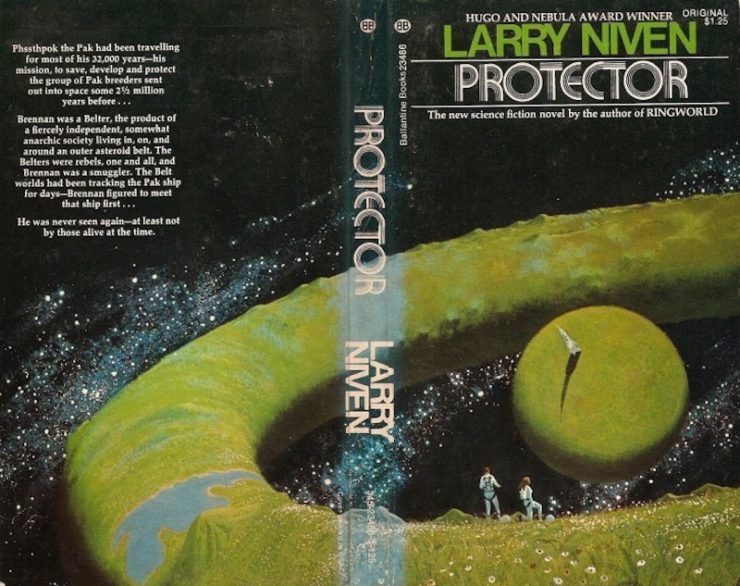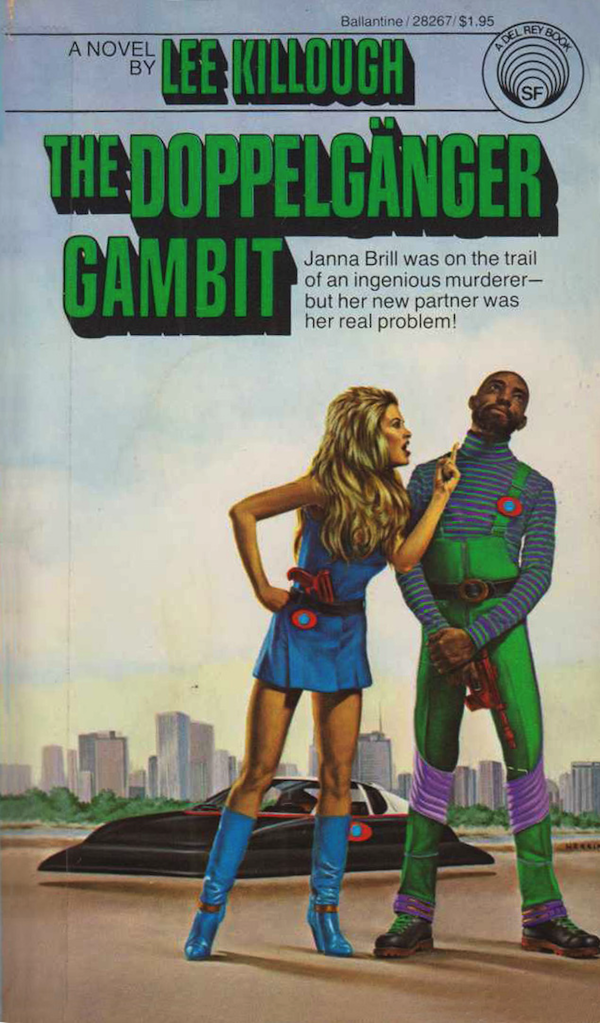When it comes to book covers, sales departments have often had more clout than the poor beleaguered author. Covers are designed to catch the eye and spur sales; any resemblance to what is actually in the book may be coincidental. I think the publishing world (well, the reputable publishing world) has been getting somewhat better at producing covers that are handsome rather than garish and that do justice to the contents of the book. But in decades past… publishers plastered some really, really deceptive covers on their output. They had a notion of what would attract a stereotypical SF reader and that’s what they told the artist to paint. If old-time covers are any guide, SF fans were perceived as liking space ships, grim-faced men with guns, and naked women (as documented in the song “There’s a Bimbo on the Cover of My Book,” sung to the tune of “She’ll Be Coming ‘Round the Mountain”). With the exception of the readers of Berkley SF, who, judging by all the Richard Powers covers, were seen as attracted mainly by blobs and lava lamps.1
It would be easy (like shooting fish in a barrel) to offer examples of hilariously inappropriate cover art from the days of my youth. I could eke a compelling essay out of the covers that forced me to explain (yet again) to my teachers that no, I had not brought pornography to school.
I’ve decided to take the high road: Here are five covers that delivered exactly what they promised (even if that might seem unlikely…).
And because I like to spread praise around, this essay is not going to be “Five Covers by Michael Whelan.” It could be, because it’s clear he reads the books for which he creates covers, but it isn’t.
Inherit the Stars by James P. Hogan, 1977, cover by Darrell K. Sweet
I’ve never been a great fan of the works of the late Mr. Sweet, but this cover did exactly that it was supposed to do: convince me to take the book off the shelf and hand the proprietor a buck fifty. Not only that, the cover didn’t lie to me. Sweet did take a few very minor liberties (in the book, the corpse is found in a cave, not out in the open), but otherwise the cover promises exactly what the novel delivers: a long-dead guy on the Moon and the story of how he got there.
Protector by Larry Niven, 1973, cover by Dean Ellis
Dean Ellis’ cover depicts something that orbital mechanics fans might dismiss as nonsensical: a torus-shaped world with a smaller, more conventional worldlet in the middle. This peculiar setting is drawn straight out of the novel, which concerns a recluse living in an odd setting enabled by super-advanced technology—it’s one of two striking settings to be found in the novel. Ellis chose the setting that wouldn’t later feature on Rick Sternbach’s cover for the mid-1970s edition of Neutron Star.
The Doppelgänger Gambit by Leigh Killough, 1979, cover by Michael Herring
Herring’s cover captures two key elements of this gripping 21st-century police procedural. The first: the two police officers don’t get along. The second: clothing fashions in this future are somehow even more hideous than real-world 1970s fashions. The cover is true to the work. Detective Janna Brill thinks Maxwell takes unconscionable risks2, and these are the clothes described in the novel. (Though I suspect the cops in the novel used holsters.)
Lamarchos by Jo Clayton, 1978, cover by Michael Whelan
As previously mentioned, Whelan clearly reads the books for which he paints covers. Readers who purchased this Diadem novel bought it secure in their faith that at some point series, protagonist Aleytys would get medieval on an offending space craft. Indeed, the scene in question occurs towards the end of the novel. There’s just one puzzler: what the heck is Aleytys crouching on?
Forerunner Foray (Warlock series, third book) by Andre Norton, 1973, cover by Charles Mikolaycak
Readers might think that Mikolaycak’s striking cover for Norton’s third Warlock novel is a collection of generic images intended to alert readers to the fact that this is an SF novel. But most of the elements on the cover—the woman, the stone, the man with the migraine, and the six-limbed toucan—can, in fact, be found in the book.
So, there you have it: five striking 1970s covers for which the artist read the book. No doubt you have your own favorites—feel free to mention them in comments.
Originally published December 2, 2019.
In the words of Wikipedia editor TexasAndroid, prolific book reviewer and perennial Darwin Award nominee James Davis Nicoll is of “questionable notability.” His work has appeared in Publishers Weekly and Romantic Times as well as on his own websites, James Nicoll Reviews and Young People Read Old SFF (where he is assisted by editor Karen Lofstrom and web person Adrienne L. Travis). He was a finalist for the 2019 Best Fan Writer Hugo Award, and is surprisingly flammable.
[1]I realize I’ve left out one school of 1970s cover art: assemble random elements half an hour before deadline.
[2]Brill is a methodical plodder, but she ends up with fewer bullet holes.















